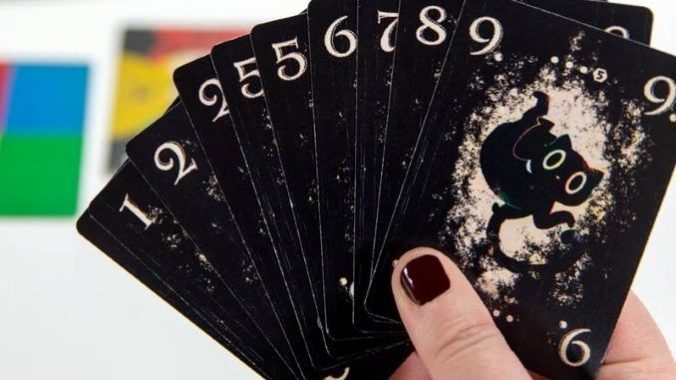Until You Play Cat in the Box You Are Simultaneously a Winner and a Loser

At Gen Con this year, I ran into a teenaged girl who was very excited to show me (or anyone in sight) that she had bought Cat in the Box: Deluxe Edition, because it was “cute” and had a cat on the cover. Maybe she really knew what a brilliant but challenging game was in the box and didn’t just buy it for the adorable box art. If so, I hope she forgives me for thinking, “oh, I really hope you know what you just bought.” I love this game, but Silly Cat Game it is not.
Cat in the Box, which is a new version of a game first published in Japan in 2020, is a trick-taking game that takes inspiration from the (in)famous thought experiment by physicist Erwin Schrödinger known as Schrödinger’s cat. In this hypothetical situation, there’s a cat in the box with a radioactive substance that has a 50% chance of having one of its atoms decay in a one-hour period. If that happens, a device within the box will shatter a glass with hydrocyanic acid (a.k.a., cyanide gas) in it, killing the cat. You can’t know if the cat is alive or dead until you open the box, but by doing so—observing the experiment—you also affect the experiment’s outcome, condensing all possible states, meaning the two where the cat is alive or the cat is dead, into one. The interpretations of this experiment vary depending on the school of quantum mechanics; one holds that the cat is both simultaneously alive and dead in the box, which, I contend, is not a thing.
Anyway, Cat in the Box turns this concept into a core part of game play: The cards don’t have suits (colors) until they’re played. They could be any of the four suits in the game until they’re observed by all players. When you play a card from your hand, you declare its suit. That specific suit-number combination must not have been played already in that round, and the player playing that card must still have that suit active—meaning that they haven’t previously declared themselves to be out of that suit. Otherwise, anything goes. The red suit is always the trump suit, and players must follow suit if they “can.” Of course, you can usually follow suit unless that entire color has been played in the current round, but you may choose not to do so for strategic reasons.

-

-

-

-

-

-

-

-

-

-

-

-

-

-

-

-

-

-

-

-

-

-

-

-

-

-

-

-

-

-

-

-

-

-

-

-

-

-

-

-








































